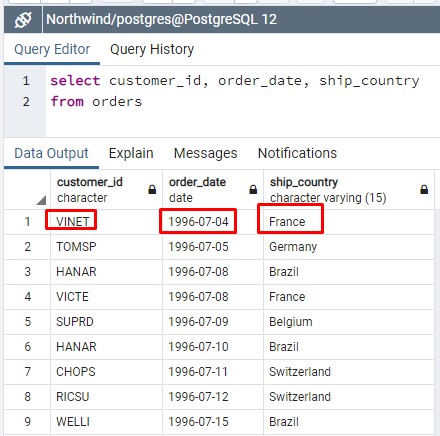

If the first was rolled back, the next transaction takes the lock and proceeds normally others in the queue keep waiting.
UPDATE QUERY IN POSTGRESQL UPDATE
Without SKIP LOCKED in PostgreSQL 9.4 or older UPDATE server_infoĬoncurrent transactions trying to lock the same row are blocked until the first one releases its lock. (Or new rows have been added meanwhile.) Wait a bit, then loop the two steps: ( UPDATE till you get no row back SELECT. Wile that doesn't return true, one or more rows are still unfinished and transactions could still be rolled back. To be sure run a final check: SELECT NOT EXISTS ( However, concurrent transactions may have locked rows, but then don't finish the update ( ROLLBACK or other reasons). For uncritical operations that means you are done. If there is no qualifying, unlocked row left, nothing happens in this query (no row is updated) and you get an empty result. Used to avoid lock contention with multiple consumers accessing a Skipping locked rows provides an inconsistent view of theĭata, so this is not suitable for general purpose work, but can be With SKIP LOCKED, any selected rows that cannot be immediately lockedĪre skipped. SKIP LOCKED was added in Postgres 9.5, for older versions see below. Under concurrent write load, add FOR UPDATE SKIP LOCKED to lock the row to avoid race conditions. SELECT … FOR UPDATE SKIP LOCKED in REPEATABLE READ transactions.Stricter isolation levels ( REPEATABLE READ and SERIALIZABLE) may still result in serialization errors. Simpler, faster: UPDATE server_infoĪssuming default isolation level READ COMMITTED for all of this. Or use a lowly correlated subquery for the simple case with LIMIT 1. The way to fix the above was to wrap the LIMIT subquery in its own CTE, as the CTE is materialized it will not return different results on different iterations of the nested loop. The planner may choose to generate a plan that executes a nested loop over the LIMITing subquery, causing more UPDATEs than LIMIT, e.g.: Update on buganalysis rows=5 I originally had a plain subquery here, but that can sidestep the LIMIT for certain query plans as Feike pointed out:

SELECT server_ip - pk column or any (set of) unique column(s)
UPDATE QUERY IN POSTGRESQL MANUAL
Refer to the manual on UPDATE for details.Materialize a selection in a CTE (Common Table Expressions) and join to it in the FROM clause of the UPDATE. If you want different values to be used for different rows of C, you'll have to join the 3 tables (using JOIN - ON and WHERE) It then uses the values from that arbitrary row to update all rows of table C. without any joining condition) and then choosing an arbitrary row ( LIMIT 1 without ORDER BY). Your derived table is cross joining A and B (i.e. Ypercube already gave a basic explanation in his comment (now removed):
UPDATE QUERY IN POSTGRESQL FULL
The last WHERE clause is optional to avoid empty updates that would not change anything (but still write a new row version at full cost). (A.column1, B.column2, A.column1 + B.column2) WHERE C.id = A.id - ? not specified in question!ĪND (C.column1, C.column2, C.column3) IS DISTINCT FROM JOIN B ON A.id = B.id - ? not specified in question! The proper form would be (assuming current pg version 9.3 for lack of information): UPDATE C


 0 kommentar(er)
0 kommentar(er)
